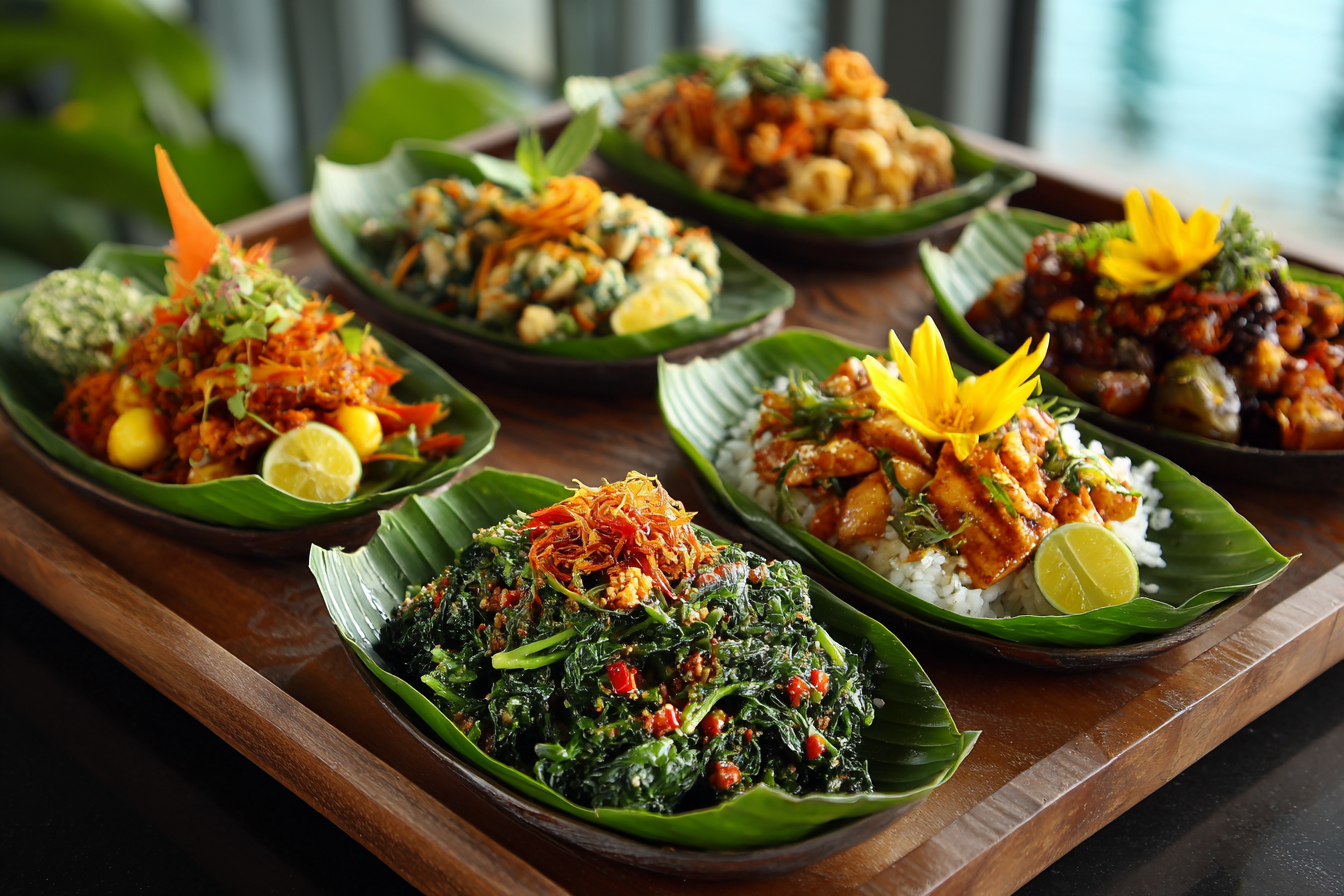Bali’s vibrant town of Kuta is not just famous for its stunning beaches and lively nightlife, but also for its diverse and flavorful local cuisine. The island’s culinary heritage is deeply rooted in its culture, traditions, and the abundance of fresh ingredients available all year round. Whether you’re a food enthusiast eager to sample authentic Balinese dishes or a casual traveler looking to savor tasty street food, Kuta offers a culinary experience that will excite your taste buds. This guide to Kuta’s local cuisine will help you navigate the flavors of Bali, highlighting must-try dishes, best places to eat, cultural dining practices, and tips to ensure you enjoy your food safely and responsibly.
Introduction to Balinese Cuisine in Kuta
Balinese cuisine is a unique blend of rich flavors, aromatic spices, and fresh ingredients that reflect the island’s cultural diversity and nature’s bounty. Influenced by Hindu traditions and local customs, the food in Kuta and throughout Bali features a harmonious balance of sweet, spicy, savory, and tangy tastes. Staples like rice, coconut, spices such as turmeric and lemongrass, and various meats and seafood form the foundation of many dishes. The use of vibrant herbs and chili makes every meal an explosion of flavor, while traditional cooking methods like roasting and grilling impart a distinctive taste that is hard to forget.
In Kuta, you can find everything from humble warungs (local eateries) serving home-style Balinese food to trendy cafes putting a modern spin on traditional recipes. This melting pot of culinary options provides an exciting opportunity to discover the true flavors of Bali beyond the usual tourist fare.
Signature Dishes You Must Try
When visiting Kuta, certain dishes stand out as true representations of Balinese culinary art. Here are some signature dishes that you should definitely include in your food adventures:
- Babi Guling (Suckling Pig): Perhaps Bali’s most famous dish, Babi Guling is whole roasted pig marinated with a blend of turmeric, coriander, lemongrass, and other spices. It’s traditionally served with rice, crispy pork skin, and spicy sambal (chili paste). This dish is a must-try for meat lovers and is often featured at ceremonial feasts.
- Nasi Campur (Mixed Rice): A versatile dish consisting of white rice served with various side dishes such as vegetables, egg, chicken, tofu, and sambal. Each stall or restaurant offers its own version, making it a great way to sample multiple flavors in one meal.
- Nasi Goreng (Fried Rice): Indonesia’s beloved fried rice dish, packed with vegetables, egg, chicken or shrimp, and seasoned with sweet soy sauce. It’s commonly eaten for breakfast or dinner and is a comfort food staple.
- Sate Lilit: Minced meat (usually fish or chicken) mixed with grated coconut, coconut milk, lime leaves, and spices, wrapped around bamboo sticks and grilled to perfection. The aromatic and savory flavors make it a popular snack or appetizer.
- Bebek Betutu (Smoked Duck): A slow-cooked duck stuffed with spices and wrapped in banana leaves, resulting in tender, flavorful meat. This ceremonial dish is rich and satisfying, often reserved for special occasions but found in some Kuta restaurants.
- Lawar: A traditional Balinese salad made from chopped vegetables, grated coconut, minced meat or fish, and a mixture of rich spices. It’s usually served alongside rice and main dishes.
Best Local Eateries and Markets
Finding authentic Balinese flavors in Kuta is easy if you know where to look. The town is dotted with local warungs, markets, and restaurants that offer fantastic food experiences at all budget levels.
- Warung Murah: A popular spot famous for affordable and authentic Balinese dishes. Guests praise their nasi campur and sate lilit, plus the unpretentious atmosphere adds to the charm.
- Jalan Legian Street Stalls: This bustling street is lined with small vendors selling snacks, grilled seafood, and traditional sweets. Sampling street food here is a delightful way to experience Kuta’s lively food culture.
- Kuta Night Market (Pasar Senggol Kuta): Best visited during the evenings, this night market offers a variety of local specialties, from babi guling to freshly made desserts. The vibrant atmosphere and affordable prices attract both locals and tourists.
- Bambu Indah Restaurant: For those seeking a higher-end dining experience, Bambu Indah offers beautifully crafted Balinese dishes made from organic, locally sourced ingredients. Their presentation and flavors highlight the richness of the island’s culinary heritage.
Food Customs and Dining Etiquette
Understanding local customs and dining manners enriches the culinary experience and shows respect to Balinese culture. Here are some key etiquette tips to keep in mind while enjoying local cuisine in Kuta:
- Sharing is common: Meals are often communal, and dishes are shared among family or friends. Don’t hesitate to try a bit of everything.
- Use the right hand: Traditionally, eating with your right hand is preferred since the left hand is considered less clean. However, in more tourist-focused spots, utensils are commonly used.
- Respect food offerings: Balinese often make offerings of food to their gods as part of daily rituals. These offerings should never be disturbed or eaten.
- Finish your plate: Leaving food uneaten might be considered wasteful or disrespectful. Eat what you can and politely decline more if you’re full.
Cooking Classes and Culinary Tours
For those who want to take their food adventure to the next level, Kuta offers several cooking classes and culinary tours that immerse visitors in the preparation and culture behind Balinese cuisine:
- Balinese Cooking Workshops: Many local cooking schools offer hands-on classes where you learn to prepare popular dishes like babi guling, sate lilit, and lawar under the guidance of experienced chefs or local families. These classes often begin with a visit to the traditional market to select fresh ingredients.
- Food Tours: Guided tours take you through local markets, street stalls, and hidden eateries, offering tastings and stories about each dish’s history and significance. This is a fantastic way to experience Kuta’s food scene with insider knowledge.
Tips for Food Safety and Dietary Needs
While exploring Kuta’s exciting local cuisine, it’s important to prioritize your health and specific dietary requirements. Here are some practical tips to ensure a safe and enjoyable culinary experience:
- Eat at busy places: Popular warungs and stalls with many local customers usually have fresh and safe food turnover.
- Drink bottled water: Avoid tap water and ice cubes made from it to prevent stomach issues.
- Communicate dietary restrictions: Vegetarians, vegans, or those with allergies should clearly state their needs. Some dishes may contain fish sauce or shrimp paste, so double-check with the vendor or restaurant.
- Try cooked foods: To reduce risks, choose cooked dishes over raw or undercooked foods when unsure.
Experience Bali Through Its Flavors
Taste is a powerful gateway to cultural understanding, and Kuta’s local cuisine offers a rich palette of flavors that tell stories of tradition, community, and nature. By trying signature dishes, visiting local eateries, respecting food customs, and perhaps even learning to cook Balinese food yourself, you’ll bring back much more than just delicious memories. Whether you’re nibbling street snacks or enjoying a ceremonial meal, the culinary journey in Kuta is sure to be one of the highlights of your Bali adventure.







